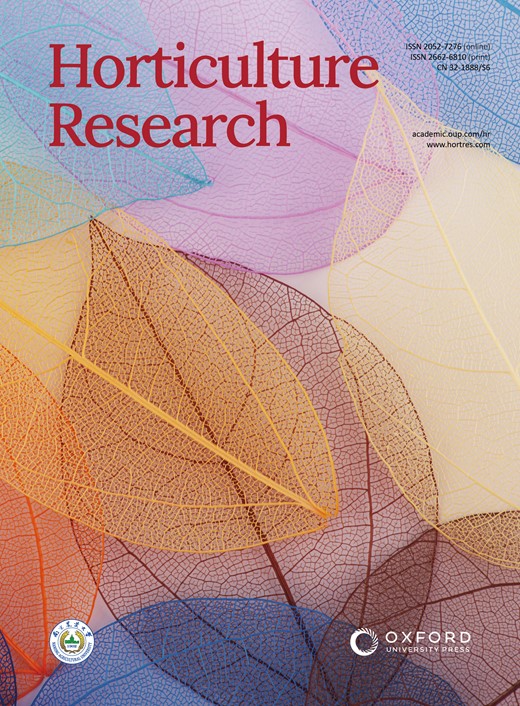接穗驱动的转录组变化指导着近等水性嫁接葡萄藤在缺水条件下的恢复能力
IF 8.7
1区 农林科学
Q1 Agricultural and Biological Sciences
引用次数: 0
摘要
葡萄栽培品种种类繁多,其中包括比其他品种更耐缺水的基因型。分布广泛的栽培品种,如美乐,比当地的栽培品种,如卡莱,对缺水更为敏感。尽管它们具有耐受性,但对缺水的适应性受砧木(如 110 Richter)嫁接的影响,是葡萄园应对干旱的关键,也决定了接穗与砧木之间的关系。为了了解这些差异,我们以 110 Richter 作为两个栽培品种的砧木,探讨了三种程度(轻度、高度和极端)的水分亏缺下的转录组、代谢、激素和生理反应。结果表明,对 ABA 的敏感性是气生部分耐受水分亏缺的必要条件,并能指导根系的反应。与 Merlot/110 Richter 相比,Callet/110 Richter 对 ABA 的反应激活了更多的基因表达模式,减少了气生部分和根部的水分损失。Callet/110 Richter 的这种调节包括调节新陈代谢途径以增加细胞张力、减少光合作用以及产生多酚或类黄酮等分子以应对氧化应激。相比之下,Merlot/110 Richter 缺乏特异性反应,尤其是在根部,这表明其对水分胁迫的恢复能力较弱。因此,选择对 ABA 更为敏感的基因型及其与砧木的相互作用是在未来气候变化情况下管理葡萄园的关键。本文章由计算机程序翻译,如有差异,请以英文原文为准。
The scion-driven transcriptomic changes guide the resilience of grafted near-isohydric grapevines under water deficit
The large diversity of grapevine cultivars includes genotypes more tolerant to water deficit than others. Widely distributed cultivars, like Merlot, are more sensitive to water deprivation than local cultivars like Callet, which are more adapted to water deficit due to their Mediterranean origin. Despite their tolerance, adaptation to water deficit influenced by grafting in rootstocks like 110 Richter is key to facing drought in vineyards, defining the scion/rootstock relationship. To understand these differences, we explored transcriptomic, metabolic, hormonal and physiological responses under three levels of water deficit (mild, high and extreme), using 110 Richter as the rootstock in both cultivars. Results revealed that sensitivity to ABA is essential for water deficit tolerance in the aerial part, guiding root responses. Callet/110 Richter activates more gene expression patterns in response to ABA, reducing water loss compared to Merlot/110 Richter in both aerial and root parts. This modulation in Callet/110 Richter involves regulating metabolic pathways to increase cell turgor, reducing photosynthesis, and producing molecules like polyphenols or flavonoids to respond to oxidative stress. In contrast, Merlot/110 Richter shows a lack of specific response, especially in the roots, indicating less resilience to water stress. Therefore, selecting genotypes more sensitive to ABA and their interaction with rootstocks is key for managing vineyards in future climate change scenarios.
求助全文
通过发布文献求助,成功后即可免费获取论文全文。
去求助
来源期刊

Horticulture Research
Biochemistry, Genetics and Molecular Biology-Biochemistry
CiteScore
11.20
自引率
6.90%
发文量
367
审稿时长
20 weeks
期刊介绍:
Horticulture Research, an open access journal affiliated with Nanjing Agricultural University, has achieved the prestigious ranking of number one in the Horticulture category of the Journal Citation Reports ™ from Clarivate, 2022. As a leading publication in the field, the journal is dedicated to disseminating original research articles, comprehensive reviews, insightful perspectives, thought-provoking comments, and valuable correspondence articles and letters to the editor. Its scope encompasses all vital aspects of horticultural plants and disciplines, such as biotechnology, breeding, cellular and molecular biology, evolution, genetics, inter-species interactions, physiology, and the origination and domestication of crops.
 求助内容:
求助内容: 应助结果提醒方式:
应助结果提醒方式:


